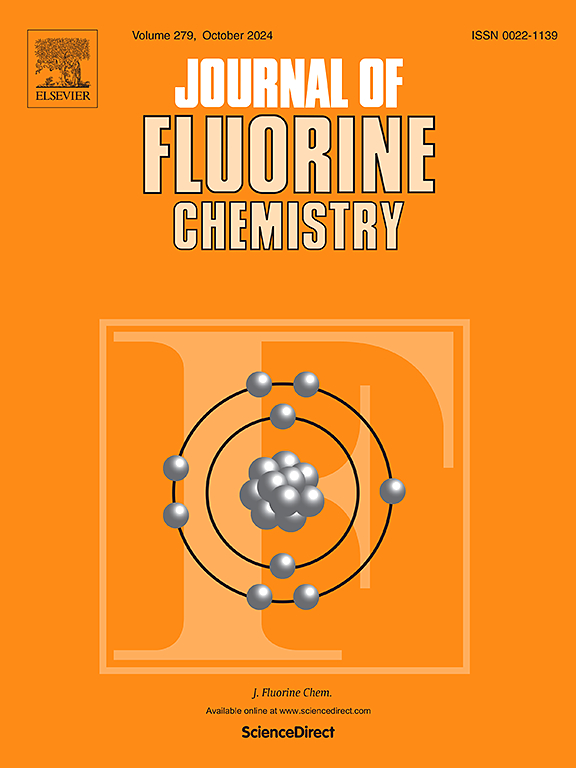Structural characterization of new Tl+ and Pb2+ oxyfluoridozirconates deriving from hexagonal layer structures of M’xM3×9–13 general formula
IF 1.9
4区 化学
Q3 CHEMISTRY, INORGANIC & NUCLEAR
引用次数: 0
Abstract
A new series of Tl+ and Pb2+ oxyfluoridozirconates is isolated and structurally described in hexagonal symmetry, P63/mmc space group and close lattice parameters (a = 7.649 Å and c = 15.797 Å for Tl0.69Zr3O1.91F8.87; a = 7.647(2) Å and c = 15.835(4) Å for Pb0.714Zr3O2.90F7.62). The refined Tl content varies from 0.69/1 to 0.90/1 (0.71 to 0.76 for Pb) and is never stoichiometric. Their structure corresponds to a stacking of hexagonal layers containing a strong framework of ZrOF7 bicapped trigonal prisms and ZrO2F5 pentagonal bipyramids sharing edges and vertices and forming triangular clusters of formula comprised between Zr3OF18 and Zr3O4F12. These units are all centered on one O anion and interconnected via F corners with three other triangular units forming layers delimiting holes of distorted hexagonal section partly occupied by Tl+ or Pb2+ cations.
This new type is compared to many structures presenting various stackings of similar hexagonal or pseudo-hexagonal layers with M3+ or M4+ cations of high size coordinated by 6, 7, 7 + 8, 8, 8 + 9, 9 F and/or O anions. All belong to a same family of phases of M’xM3X9–13 general formula.

M - 'xM3×9-13通式六方层结构衍生的新型Tl+和Pb2+氧氟锆酸盐的结构表征
在Tl0.69Zr3O1.91F8.87中分离出了一系列新的Tl+和Pb2+氧氟锆酸盐,并以六方对称、P63/mmc空间群和接近的晶格参数(A = 7.649 Å和c = 15.797 Å)进行了结构描述;对于Pb0.714Zr3O2.90F7.62, a = 7.647(2) Å, c = 15.835(4) Å)。精炼后的Tl含量在0.69/1到0.90/1之间变化(Pb含量为0.71到0.76),并且不具有化学计量学意义。它们的结构对应于六边形层的堆叠,其中包含由zro2f7二头三角形棱柱和ZrO2F5五边形双棱柱组成的强框架,共享边缘和顶点,形成由Zr3OF18和Zr3O4F12组成的三角形团簇。这些单元都以一个O阴离子为中心,并通过F角与其他三个三角形单元相互连接,这些三角形单元形成的层划分了部分由Tl+或Pb2+阳离子占据的扭曲六边形截面的孔。这种新型结构与许多具有类似六边形或拟六边形层的不同堆叠的结构进行了比较,这些结构具有高尺寸的M3+或M4+阳离子,由6,7,7 + 8,8,8 + 9,9 F和/或O阴离子协调。均属于M 'xM3X9-13通式的同族相。
本文章由计算机程序翻译,如有差异,请以英文原文为准。
求助全文
约1分钟内获得全文
求助全文
来源期刊

Journal of Fluorine Chemistry
化学-无机化学与核化学
CiteScore
3.80
自引率
10.50%
发文量
99
审稿时长
33 days
期刊介绍:
The Journal of Fluorine Chemistry contains reviews, original papers and short communications. The journal covers all aspects of pure and applied research on the chemistry as well as on the applications of fluorine, and of compounds or materials where fluorine exercises significant effects. This can include all chemistry research areas (inorganic, organic, organometallic, macromolecular and physical chemistry) but also includes papers on biological/biochemical related aspects of Fluorine chemistry as well as medicinal, agrochemical and pharmacological research. The Journal of Fluorine Chemistry also publishes environmental and industrial papers dealing with aspects of Fluorine chemistry on energy and material sciences. Preparative and physico-chemical investigations as well as theoretical, structural and mechanistic aspects are covered. The Journal, however, does not accept work of purely routine nature.
For reviews and special issues on particular topics of fluorine chemistry or from selected symposia, please contact the Regional Editors for further details.
 求助内容:
求助内容: 应助结果提醒方式:
应助结果提醒方式:


